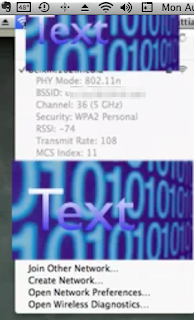OSX networking and security tips - a crash course
Your Mac doesn't usually need a lot of maintenance, but it can come in handy to know some basic networking functionalities and some useful tips to ensure a better security to your system.
- Use Network Utility to check Internet and connectivity problems: Network Utility is a built-in Mac utility that can help you a lot troubleshoot network and Internet problems. It can be easily launched from Spotlight and gathers several network tools into one. Info tab shows you more information on your network, such as IP address and MAC address of your network card. Netstat displays all open connections on your network along with network statistics; Ping is especially useful to troubleshoot Internet problems because allows to send ICMP packets to a server to see if you're connected (if you ping a website such as www.google.com and you get an answer, i.e. your packets are successfully received, your Internet connection is working correctly, otherwise you have problems and you'll see a request timeout error message, as shown in the figure below). Lookup allows to find the IP address associated to a certain domain. Traceroute displays the route and transit delays of packets along an IP network (in Windows-based systems you need to use tracert, running it from Command Prompt). In other words, this command will display all steps (hops) to understand what route a packet follows from your computer to a certain server, and will show which one has problems, causing the connection to fail.



- Gather more information about your network by clicking the Wi-Fi icon on the menubar: By pressing down the Alt key (a.k.a. Option key) while right-clicking the Wi-Fi icon, you can get more information about your network (protocol used, channel used, encryption type, transmission rate, etc.).

- Never activate Remote Management, Remote Login or Remote Apple events: Unless you really need it for troubleshooting or other purposes, make sure to deselect these functionalities from System Preferences/Sharing. If you enable them, you allow other users (and a potential attacker) to login to your Mac, to manage your Mac through Apple Remote Desktop or allow applications on another Mac to send Apple events to your Mac. It's like a broken window, you get too many high gusts from there, so close it and you'll thank me.

- Activate Apple Firewall and make sure to enable Stealth Mode: Apple Firewall is disabled by default, which means you're vulnerable to port scanning and other attack techniques. You want to make sure you enable it, as soon as you start using your Mac, by going to System Preferences/Security & Privacy/Firewall. There you'll have to click the padlock icon to enter your administrative password and enable the firewall. That done, click Firewall Options and make sure to enable Stealth Mode. This is important, because this way your Mac won't respond or acknowledge to attempts to access to your computer through Ping, port scans or other techniques. In other words, your Mac will drop all packets and it'll result you're not even there, so an attacker will be up against a brick wall.

Comments
Post a Comment